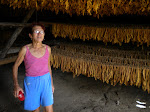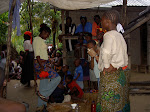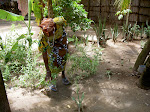ABSTRACT
Background
and objective: the HIV epidemic in Mozambique is a public
health problem. The Mozambican National Health Service expanded treatment with
Antiretroviral therapy (ART) to all districts of the country in 2009.
Unfortunately the expansion of ART was followed by a high rate of ART
non-compliance thought to be due to inadequate food intake and difficulty
accessing health centres due to transport and resource availability issues. Causes
of non-compliance with treatment have not been well researched. Our research
evaluates ART adherence rates in Nampula Province and treatment non-compliance
reasons.
Methods: a
quantitative cohort study was undertaken in 5 health centres in areas of
Nampula Province. Surveys were done with patients on treatment and patients who
are non-compliant with therapy. Patient information documents (clinical files,
pharmacy and statistical records) were
also consulted.
Results: ART
non adherence rates attained 40%. We surveyed 208 patients who were ART
adherent and 86 patients who were non-compliant with therapy, 70% were female,
between 18 and 62 years of age. The main reason for treatment non-compliance
(36%) was the stigma attached to having HIV; 58% of all people do not have
enough food, 37% suffer from depressive ideation and 18% abuse substances,
mainly alcohol. ART adherence (>95% of pills are taken for the last three
months) is 69%, but 36% of people who are adherent have a CD4 count under 350
and 63% are not following the Health Ministry recommended treatment protocol.
Discussion: families
and local communities percept stigma of having HIV is considered the main
reason for ART non-adherence, but food insecurity and depression are also
important determinants. Although poor health services occupy the last position
in ART cessation causes, many patients are not following the recommended treatment
protocol due to Health Centre deficits. ART adherence rate of 69% explains the high
incidence of opportunistic infections (27%).
Conclusion:
ART non-adherence in Nampula is a serious and complex problem due to
individual, social and health system factors. It will be necessary to develop
an interdisciplinary intervention with patients and their families, health
professionals and traditional healers, to reverse this situation and improve the long term outcome of HIV patients.
KEY WORDS: ART non-compliance,
ART non-adherence, Nampula, Mozambique.
1. INTRODUCTION
Worldwide in 2010 about 34 million people were
living with Human Immunodeficiency Virus (HIV) and almost half (47%, 6.6
million) of 14.2 million people eligible for treatment had access to
antiretroviral treatment (ART).[1]
The United Nations General Assembly (2011) Political
Declaration on HIV and Acquired Immune Deficiency Syndrome (AIDS), made the
following findings:
- "The International Drug Purchase
Facility based on innovative financing and focused on access, quality and
reduction of prices of antiretroviral medicines (ARV) allowed the expansion of
access to ART.
- Access to safe, effective, affordable,
good-quality medicines and commodities in the context of epidemics such as HIV
is fundamental to the full realization of the right of everyone to enjoy the
highest attainable standard of physical and mental health."[2]
Adherence to ART is the key factor in determining
the degree and duration of viral suppression[3]. A
study in Spain showed that inadequate social and family environments diminish
the adherence rate to ART[4].
Another study in Uganda found that "in patients on ART, routine laboratory
monitoring is associated with better health and survival compared with clinical
follow-up alone".[5]
The Mozambican population has suffered a significant
negative impact due to HIV infection in terms of morbidity an mortality. One of
the challenges is the increasing burden on the health system, which suffers a
general lack of health professionals, especially in rural areas. In 2011
Mozambique had a HIV prevalence of 11,5% prevalence and about 46% on ART[6]
compared to 3,500 patients receiving treatment in 2003, attesting to the
effectiveness of the Health Ministry’s efforts to bring ART to all the country's
districts.
Professional experience over six years in HIV
clinics in Mozambican Zambezia and Nampula provinces and other health professionals’
testimonies underline food insecurity and low accessibility to health services as
the two main difficulties for ART expansion in Mozambique.
In the last three years treatment withdrawals numbers
have increased significantly, causing a new public health challenge, due to the
danger of quickly developing resistance to ARV’s if therapy is interrupted. In
Nampula province, HIV infection prevalence rate is below 10% (national average
16%).[7] However
ART non-compliance can cause the spread of resistant viruses and increase
mortality.
Thus the HIV problem is still worrying and faced
with this situation, Lúrio University Health Sciences Faculty (HSF) did the
following: 1) planned knowledge translation programme necessary for the
development of local communities; 2) acquired financing from the Institutional
Development Fund of the Ministry Education to fund this project. Another reason
to study ART adherence[8]
and ART cessation determinants in Nampula, is the absence of systematic
knowledge regarding these determinants[9] [10]. Having
a clear idea of these determinants will allow the researchers to implement
actions to reduce this public health problem.
The research two main objectives are: 1) evaluate
ART adherence[11]
[12]
in Nampula province health centres (HC); 2) identify ART cessation main factors
in these patients.
2. METHODOLOGY
Descriptive cohort study using quantitative and
qualitative methods[13].
Study population: patients seeking care in five
HC in Nampula province during 2014 and enrolled to take ART, including those
who are adherent and those who are non-compliant with ART or ceased ART.
Sample: the number of patients to be surveyed in
each district (in treatment and who ceased therapy) was calculated using the
formula (n = pq Ɛ2 / i) where (n = sample number of subjects, ɛ =
1.96, p = ART last dropout rate prevalence in the HC, q = 1 - p, considering a
confidence range = 98%, i = 0.02 error limit). It was added a margin of 10% for
occasional losses or dropouts, and calculated 165 patients on ART and 165 patients
who are non-adherent to meet the above parameters. The subjects on ART were
randomly chosen, according to a random date of query to ART service. It was
used a snowball sampling to find people who were non-compliant with therapy
(with active search, AS, and individual availability signing an informed
consent form).
Inclusion criteria: districts with prevalence of
HIV and ART's cessation rate higher than the provincial average, and an ART
program that is implemented in a HC with accurate statistical data including geographic
location, and evidence of voluntary participation.
Non-inclusion criteria: patient who does not sign
an informed consent form.
Exclusion criteria: patients with acute illness
or intoxication, or who wished to withdraw from the study.
Variables: district, gender, age, on ART, adherence,
education, time in treatment, number of doses and pills per day, depression,
consumption of psychotropic substances, family support, membership in Community
Adherence Support Group (CASG), use of traditional medicine, knowledge about
risks of poor adherence, attendance for ARV pharmacy refills in the last 3
months, food availability, Body Mass Index (BMI), medication intake failure over
the last 72 hours and last month[14],
last CD4 count level and date, alleged causes of ART non-compliance, occurrence
of diarrhoea or vomiting in the last week and Tuberculosis (TB) in the last
month.
ART dropout data were reviewed through the Nampula
Provincial Health Directorate (NPHD) and statistical districts HC records. HC
ART program leaders were interviewed. Seven questioners were selected
(completed secondary education, fluency in the local language, unrelated to the
health care system, unknown to respondents), trained and signed ethical
commitment term for undertaking the active search (patients who had abandoned
ART) within a HC pedestrian radius (five kilometres), being paid 100 meticais
(2.5 euro) per survey.
The study followed five phases: 1) districts and
HC selection: documental analysis and geographical criteria: HC 25 September,
Nampula City - urban; Nacaroa HC - corridor; Lalaua HC - rural; Murrupula HC - corridor;
Mossuril HC - coast (see Annex Table III); 2) target groups identification:
patients on ART, patients who dropped out ART; documental analysis (HC
statistics and medical records, see Annex Table IV); 3) references about dropout
causes in ART services were searched and reviewed; 4) patients surveys[15],
review of Pharmacy ARV dispensing registers and interviews with health
professionals in charge of HC ART program[16];
5) data introduction in Statistical Package for Social Sciences 21, data
processing, inferential (bivariate) analysis and interpretation of results[17].
The following risks were considered and
prevention methods applied to avoid bias: institutional risks – statistical
indicators health records low reliability controlled by gathering information
locally at HC; poor individual medical records, controlled by patients clinical
examination; target group risks - reliability of survey responses, controlled by
triangulation questions, records in clinical files and HC pharmacy.
The research protocol was approved by the Lúrio
University Institutional Bioethics Committee for Health and by NPHD and the research
complied with all Helsinki Declaration recommendations (2013).
3. RESULTS
ART cessation rates collected in district HC
monthly statistics vary from 40% (Nacaroa) to 7% (Nampula), with an average of
11%. Were surveyed 295 subjects (208 on ART surpassing the calculated sample
and 86 cessations, lower than expected due to missing or incorrect information
in medical records for their location by the inquirers in the AS), 70% were female,
between 18 to 62 years old. ART cessation rates were inversely proportional to
age and 81% of patients have an inadequate level of education (illiterate or
primary level) and had limited comprehension and expression of Portuguese which
is the official language of the country. The following table shows patients
reported causes for ART cessation.
Table I: patients reported ART cessation
causes (86).
Depression[19]
signs or symptoms are or were present in 37% of the group (295) but the
majority (82%) said they do not consume psychotropic substances[20]
(alcohol consumption[21] [22]
was seen in 15%); 58% consider that they lack sufficient food; severe under
nutrition (BMI <18 .5="" 12="" in="" is="" o:p="" present="">
Table II: risk factors for ART cessation
(295)
In ART patients (208) 27% missed taking at least
one dose over the last 3 days and 33% failed at least once in the previous
month[24] (failure
of two or more doses was observed in 23%); 26% did not regularly pick up ARV in
HC Pharmacy during last 3 months[25] (ARV
refill for these patients is limited to HC Pharmacy). ART adherence (> 95%
doses taken[26]
in the last three months) estimated average in 5 districts stands at 69% but
36% had a low CD4 count (<350 18="" 63="" 6="" 9="" and="" art="" by="" comply="" count="" diarrhoea="" do="" every="" in="" incidence="" last="" monitoring="" month="" months="" not="" o:p="" occurrence="" of="" or="" protocol="" reported="" the="" tuberculosis="" vomiting="" was="" week="" with="">
4. DISCUSSION
The researchers were initially challenged by
insufficient and unreliable information at central level (NPHD) and in the HC,
including that in clinical files that did not allow the AS for absentees and cessations.
ART cessation rates are underestimated in districts HC HIV programme indicators
statistics. ART cessation main reason pointed by patients, stigma and
discrimination, as also pointed out by other authors[27], is
confirmed by the significant lack of family support. The low level of
education, also confirmed by the literature[28],
could explain the second cessation cause, travelling, because patients did not
change residence but did not make the documentation transfer for benefiting ART
at the new HC. Depression diagnosis suspicion is quite prevalent in the group
and confirms other studies[29] [30]
but does not appear in clinical records (and the majority of HC has no antidepressant
drugs). Food insecurity[31]
is highly prevalent in this group and yet not reported by patients as a cessation
cause. Although HC poor health service occupies the last place in cessation
causes, the number of doses and tablets[32]
(higher than stipulated in the ART program), the last CD4 blood collection date
(more than 6 months) and the patients’ lack of knowledge about poor adherence risks,
reveal that many patients are not following the recommended ART protocol due to
a deficit in HC services quality. Still CASG are weakly set in all districts,
their role to support these patients is insignificant and even unsure. Patients
on ART adherence (> 95% of dose[33])
estimated average in 5 districts for the last three months stands at 69%, below
other studies in Africa[34],
what may explain the poor results in CD4 count (< 350) and the occurrence of
opportunistic infections (27%).
5. CONCLUSION
The ART non adherence rate in Nampula, depends
mainly on patient’s food insecurity and social stigma. It is a serious and
complex public health problem, resulting from individual factors (patient’s
educational and economic low level[35],[36]),
social determinants (stigma, discrimination, lack of family support[37])
and health system inadequacy. The ART adherence rate is less than the regional
average, increasing the risk of resistant HIV. The researchers think it is
necessary to improve clinical file management and health information systems and
develop a regular, systematically reviewed interdisciplinary approach among
patients[38]
and families (health information and education, CASGs design and training,
rural extension), health professionals (referral to CASGs, home visits, poor
adherence prevention strategies[39] [40] [41])
and traditional healers (healthy diet, chronic diseases, CASGs management), to
reverse this situation[42]
and reduce the incidence, morbidity and mortality caused by HIV.
ANNEXURES
Table III: HIV / ART Program District indicators (provided
by NPHD).
|
Indicators
|
February 2014
|
|||||||
|
N.
|
District
|
N⁰
People HIV + 2014
|
N⁰
Total on ART 2014
|
%
HIV+ on ART
|
HIV
Prevalence 2014 (% pregnancies)
|
HIV
Prevalence 2014
(% District Population)
|
N⁰ ART
Cessation
|
Cessation
Rates
(% ART)
|
|
1
|
Angoche
|
1526
|
1239
|
81
|
6.1
|
0.5
|
85
|
6.9
|
|
2
|
Erati
|
4639
|
3461
|
75
|
5.1
|
1.5
|
1
|
0.0
|
|
3
|
Ilha de Moçambique
|
1114
|
1277
|
115
|
7.7
|
2.0
|
102
|
8.0
|
|
4
|
Lalaua
|
1355
|
422
|
31
|
2.1
|
1.6
|
80
|
19.0
|
|
5
|
Malema
|
3845
|
1401
|
36
|
2.3
|
2.0
|
50
|
3.6
|
|
6
|
Meconta
|
2272
|
1672
|
74
|
2.4
|
1.2
|
130
|
7.8
|
|
7
|
Mecuburi
|
1342
|
1042
|
78
|
5.7
|
0.7
|
6
|
0.6
|
|
8
|
Memba
|
1654
|
554
|
33
|
1.9
|
0.6
|
44
|
7.9
|
|
9
|
Mogincual
|
690
|
925
|
134
|
1.8
|
0.4
|
37
|
4.0
|
|
10
|
Mogovolas
|
1703
|
1409
|
83
|
1.6
|
0.4
|
200
|
14.2
|
|
11
|
Moma
|
3091
|
2993
|
97
|
5.1
|
0.9
|
156
|
5.2
|
|
12
|
Monapo
|
2081
|
1499
|
72
|
2.4
|
0.6
|
138
|
9.2
|
|
13
|
Mossuril
|
894
|
581
|
65
|
5.1
|
0.7
|
77
|
13.3
|
|
14
|
Muecate
|
840
|
1329
|
158
|
6
|
0.8
|
43
|
3.2
|
|
15
|
Murrupula
|
2031
|
1125
|
55
|
3
|
1.2
|
0
|
0.0
|
|
16
|
Nacala a Velha
|
855
|
801
|
94
|
6.8
|
0.7
|
67
|
8.4
|
|
17
|
Nacala Porto
|
5691
|
7857
|
138
|
5.8
|
2.4
|
358
|
4.6
|
|
18
|
Nacaroa
|
1358
|
959
|
71
|
3
|
1.1
|
197
|
20.5
|
|
19
|
Nampula Cidade
|
18354
|
16331
|
89
|
9.8
|
3.0
|
507
|
3.1
|
|
20
|
Nampula Distrito
|
965
|
964
|
100
|
2.8
|
0.4
|
22
|
2.3
|
|
21
|
Ribaue
|
1196
|
860
|
72
|
5.1
|
0.5
|
27
|
3.1
|
|
Total
|
57496
|
48701
|
|
91.6
|
23.2
|
2327
|
|
|
|
Average
|
2738
|
2319
|
85
|
4
|
1
|
111
|
5
|
|
Table IV: HIV
/ ART Program District Indicators (collected in HC October 2014).
|
|
District
|
HC
Population
|
N⁰
HIV + Persons 2014
|
N⁰
Total on ART 2014
|
%
HIV+ on ART
|
HIV
Prevalence 2014 (% pregnancies)
|
HIV
Prevalence 2014 (% District Population)
|
N⁰ ART
Cessations
|
Cessation rate (% on ART)
|
Deaths N⁰ on ART
|
Mortality Rate (% ART)
|
|
1
|
Lalaua
|
43106
|
978
|
494
|
51
|
2
|
10.1
|
85
|
17.2
|
23
|
4.7
|
|
2
|
Mossuril
|
25102
|
519
|
269
|
52
|
4.6
|
2.4
|
80
|
29.7
|
53
|
10.7
|
|
3
|
Murrupula
|
57824
|
2024
|
1149
|
57
|
15.1
|
2.5
|
46
|
4.0
|
26
|
9.7
|
|
4
|
Nacaroa
|
35246
|
1402
|
688
|
49
|
6.1
|
8.4
|
278
|
40.4
|
54
|
4.7
|
|
5
|
Nampula
|
103404
|
13071
|
5651
|
43
|
4.9
|
25.0
|
406
|
7.2
|
79
|
11.5
|
|
|
Total
|
264682
|
17994
|
8251
|
|
32.7
|
48.4
|
895
|
10.8
|
235
|
2.8
|
|
Average
|
52936
|
3599
|
1650
|
46
|
7
|
10
|
179
|
|
47
|
|
Note: the total number of cessations in Murrupula and Nampula HC far
exceeds the monthly statistics and it is not possible to find a large number of
clinical files, so we do not exactly know the ART cessation rate in these HC.
REFERENCES
[1] Project leader, conception and
design, acquisition of data, analysis and interpretation of data, drafting the
article, final approval of the version to be published; Family and Community Medicine Specialist, Lecturer,
Health Sciences Faculty, Lúrio University, Nampula, Mozambique.
[2] Samples
preparation, acquisition of data, data analysis, interpretation of data; MD,
Lecturer, Health Sciences Faculty, Lúrio University, Nampula, Mozambique.
[3] Acquisition of
data, data analysis, revising the article; Pedagogic Sciences PhD, Lecturer, Health Sciences
Faculty, Lúrio University, Nampula, Mozambique.
[1] Michel Sidibe, UNAIDS Global report:
UNAIDS report
on the global AIDS epidemic 2010, The
global reference book on the AIDS epidemic and response, Joint United Nations Program on HIV/AIDS (UNAIDS),
WHO Library cataloguing-in-publication data, UNAIDS/10.11.E|JC1958E, 2010.
[2]
General
Assembly President, Political Declaration on HIV and AIDS: Intensifying our
Efforts to Eliminate HIV and AIDS, United Nations General Assembly, Sixty-fifth session | Agenda
item 10, A/RES/65/277, 8 June 2011.
[3] Jesus E, King E, McGuire S et al. Clinical
significance of simplicity and adherence in antiretroviral therapy,
Postgraduate Institute of Medicine, Clinical Care Options HIV, 2007,
Clinical Care
Options, LLC.
[4] Velasco
A, Suberviola S,
Esteban A et al. Factors associated with adherence in HIV patients, Farm Hosp.
2009; 33(1):4-11.
[5] Mermin
J, Ekwaru P, Were W, et al. Utility of routine viral load, CD4 cell count, and
clinical monitoring among adults with HIV receiving antiretroviral therapy in
Uganda: randomised trial. BMJ. 2011; 343.
[6] African
Health Observatory, Atlas of African Health Statistics 2014, Health situation
analysis of the African Region, World Health Organization, Regional Office for
Africa, Brazzaville, Republic of Congo, 2014; 54-56.
[7] Grupo Técnico Multissectorial de
Apoio á Luta contra o HIV / SIDA em Moçambique, Ronda de Vigilância
Epidemiológica do HIV de 2007, República de Moçambique, Ministério da Saúde,
Direcção Nacional de Assistência Médica, Maputo, 2008.
[8] Marcellin F, Spire B, Carrieri P et al. Assessing
adherence to antiretroviral therapy in randomized HIV clinical trials: a review
of currently used methods, Expert Rev Anti Infect Ther. 2013; 11(3):239-50.
[9] Nachega B, Mills J, Schechter M, Antiretroviral therapy adherence and
retention in care in middle-income and low-income countries: current status of
knowledge and research priorities, Curr Opin HIV AIDS. 2010; 5(1):70-7.
[10] Reynolds R, Adherence to antiretroviral therapies: state of the science,
Curr HIV Res. 2004; 2(3):207-14.
[11] Williams
B, Amico R, Bova C et al., A proposal for quality standards for measuring
medication adherence in research, AIDS Behav. 2013; 17(1):284-97.
[12] Berg
M, Arnsten H, Practical and conceptual challenges in measuring antiretroviral
adherence, J Acquir Immune Defic Syndr. 2006; 43 Suppl 1:S79-87.
[13] Sankar A,
Golin C, Simoni JM e col., How qualitative methods contribute to understanding combination antiretroviral therapy adherence, J Acquir Immune Defic
Syndr. 2006; 43 Suppl 1:S54-68.
[14]
Karina B, Julia A, Practical and conceptual challenges in measuring
antiretroviral adherence, J Acquir Immune Defic Syndr. 2006; 43(Suppl 1):
S79-S87.
[15]
Sullivan S, Campsmith L, Nakamura V, et al. Patient and regimen characteristics
associated with self-reported non adherence to antiretroviral therapy, PLos
One. 2007; 2(6).
[16] Stubbs A, Micek A, Pfeiffer T, et al.
Treatment partners and adherence to HAART in Central Mozambique, AIDS Care.
2009; 21(11):1412-9.
[17] Bulgiba A, Mohammed Y, Chik Z, et al. How well does self-reported
adherence fare compared to therapeutic drug monitoring in HAART? , Prev Med.
2013; 57 Suppl: S34-6.
[18] Al-Dakkak I, Patel S, McCann, et al. The impact of specific HIV
treatment-related adverse events on adherence to antiretroviral therapy: a
systematic review and meta-analysis, AIDS Care. 2013; 25(4):400-14.
[19] Reisner L,
Mimiaga J, Skeer M, et al. A review of HIV antiretroviral adherence and
intervention studies among HIV-infected youth, Top HIV Med. 2009; 17(1):14-25.
[20] Lucas M,
Substance abuse, adherence with antiretroviral therapy, and clinical outcomes
among HIV-infected individuals, Life Sci. 2011; 88(21-22):948-52.
[21] Azar M, Springer A, Meyer P, et al. A systematic review of the impact of
alcohol use disorders on HIV treatment outcomes, adherence to antiretroviral
therapy and health care utilization, Drug Alcohol Depend. 2010; 112(3): 178-93.
[22] Hendershot S, Stoner A, Pantalone W, et al. Alcohol use and
antiretroviral adherence: review and meta-analysis, J Acquir Immune Defic
Syndr. 2009;52(2): 180-202.
[23]
Sandelowski M, Voils I, Chang Y, et al. A systematic review comparing
antiretroviral adherence descriptive and intervention studies conducted in the
USA, AIDS Care. 2009; 21(8):953-66.
[24] Simoni M, Kurth E, Pearson R, et al. Self-report measures of
antiretroviral therapy adherence: A review with recommendations for HIV
research and clinical management, AIDS Behav. 2006; 0(3):227-45.
[25] Jane S,
Rivet A, Laramie S, et al. Antiretroviral adherence interventions: translating
research findings to the real world clinic, Curr HIV/AIDS Rep. 2010; 7(1): 44-51.
[26] Emamzadeh-Fard S., Fard E, Seyed S, et al. Adherence to anti-retroviral
therapy and its determinants in HIV/AIDS patients: a review, Infect Disord Drug
Targets. 2012; 12(5):346-56.
[27] Redfield R, Blattner W, New
Directions in HIV Therapy and Prevention —The Next 25 Years, Institute of Human
Virology, University of Maryland School of Medicine, From cause to care,
Commemorating 25 years of HIV / AIDS Research, The American Association for the Advancement
of Science, 2009.
[28] Peltzer K, Pengpid S., Socioeconomic factors in adherence to HIV therapy
in low- and middle-income countries, J Health Popul Nutr. 2013; 31(2): 150-70.
[29] Nakimuli-Mpungu E, Bass K, Alexandre P, et al. Depression, alcohol use and adherence to antiretroviral therapy in
sub-Saharan Africa: a systematic review, AIDS Behav. 2012; 16(8):2101-18.
[30] Nel A, Kagee A, Common mental health problems and
antiretroviral therapy adherence, AIDS Care. 2011; 23(11): 1360-5.
[31] Nancy R,
Optimizing adherence to antiretroviral therapy, inPractice, https://www.inpractice.com/Textbooks/HIV/Antiretroviral_Therapy/ch13_pt1_Adherence,
assessed 24-05-2014.
[32] Conway B, The role of adherence to antiretroviral therapy in the
management of HIV infection, J Acquir Immune Defic Syndr. 2007;45 Suppl
1:S14-8.
[33] Nischal C, Khopkar U, Saple G, Improving adherence to antiretroviral
therapy, Indian J Dermatol Venereol Leprol. 2005; 71(5):316-20.
[34] Mills J, Nachega B, Buchan I, et al. Adherence to antiretroviral therapy
in sub-Saharan Africa and North America: a meta-analysis, JAMA. 2006; 296(6):679-90.
[35] Rachlis S, Mills J, Cole C, Livelihood security and adherence to
antiretroviral therapy in low and middle income settings: a systematic review,
PLoS One. 2011;6(5): e 18948.
[36] Falagas E, Zakadoulia A, Pliatsika A, et al., Socioeconomic status (SES)
as a determinant to adherence to treatment in HIV infected patients: a
systematic review of the literature, Retrovirology. 2008; 5:13.
[37] Arrondo V, Sainz S, Andres
E, et al. Factors associated with adherence in HIV patients, Farm Hosp. 2009;
33(1): 4-11.
[38] Leeman J, Chang K, Lee J, Implementation of antiretroviral therapy
adherence interventions: a realist synthesis of evidence, J Adv Nurs. 2010;
66(9): 1915-30.
[39] Simoni M,
Amico R, Smith L, et al. Antiretroviral adherence interventions: translating
research findings to the real world clinic, Curr HIV/AIDS Rep. 2010; 7(1):
44-51.
[40] Bangsberg R,
Preventing HIV antiretroviral resistance through better monitoring of treatment
adherence, J Infect Dis. 2008; 197 Suppl 3: S272-8.
[41] Machtinger
L, Bangsbeg R, Seven steps to better adherence: a practical approach to
promoting adherence to antiretroviral therapy, AIDS Read. 2007; 17(1): 43-51.
[42] Amico R, Orrell C, Antiretroviral therapy adherence support:
recommendations and future directions, J Int Assoc Provid AIDS Care. 2013;
12(2):128-37.
































































































































































































































































































































































































































































































































































































































































































































































































































































































































Sem comentários:
Enviar um comentário